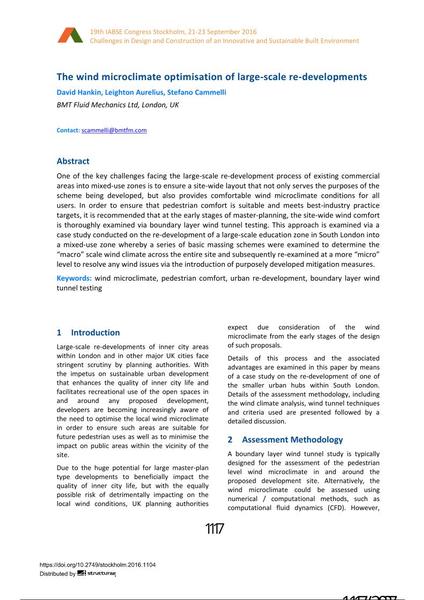The wind microclimate optimisation of large-scale re-developments

|
|
|||||||||||
Bibliographic Details
| Author(s): |
David Hankin
(BMT Fluid Mechanics Ltd, London, UK)
Leighton Aurelius (BMT Fluid Mechanics Ltd, London, UK) Stefano Cammelli (BMT Fluid Mechanics Ltd, London, UK) |
||||
|---|---|---|---|---|---|
| Medium: | conference paper | ||||
| Language(s): | English | ||||
| Conference: | IABSE Congress: Challenges in Design and Construction of an Innovative and Sustainable Built Environment, Stockholm, Sweden, 21-23 September 2016 | ||||
| Published in: | IABSE Congress Stockholm, 2016 | ||||
|
|||||
| Page(s): | 1117-1124 | ||||
| Total no. of pages: | 8 | ||||
| Year: | 2016 | ||||
| DOI: | 10.2749/stockholm.2016.1104 | ||||
| Abstract: |
One of the key challenges facing the large-scale re-development process of existing commercial areas into mixed-use zones is to ensure a site-wide layout that not only serves the purposes of the scheme being developed, but also provides comfortable wind microclimate conditions for all users. In order to ensure that pedestrian comfort is suitable and meets best-industry practice targets, it is recommended that at the early stages of master-planning, the site-wide wind comfort is thoroughly examined via boundary layer wind tunnel testing. This approach is examined via a case study conducted on the re-development of a large-scale education zone in South London into a mixed-use zone whereby a series of basic massing schemes were examined to determine the “macro” scale wind climate across the entire site and subsequently re-examined at a more “micro” level to resolve any wind issues via the introduction of purposely developed mitigation measures. |
||||
| Keywords: |
wind microclimate pedestrian comfort urban re-development boundary layer wind tunnel testing
|
||||
